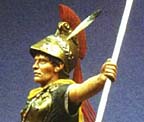 by Greg DiFranco
by Greg DiFranco
It was 211 BC and the two most powerful city-states of their time were locked in the mortal combat of the Second Punic War. It was the wealthy maritime power of Carthage pitted against Republican Rome. By now Carthage had brought Rome to the brink of total destruction, and arguably to the lowest point in its history. Hannibal and his fellow commanders had successfully defeated many Roman armies, and had completely annihilated a number of them in the process. Most notable was Hannibal’s annihilation of one of the largest armies Rome had ever assembled (70,000 troops) at the battle of Canne. Many of Rome’s most prominent citizens were lost in this battle, as in keeping with Republican Roman tradition, the most important citizens fought in the front ranks. The city of Rome itself was left almost helplessly exposed and was in chaos with the expectation of a siege. And if things weren’t desperate enough for the Romans, the Carthaginians now took complete control of Iberia (Spain), one of the most important economic areas of the region. In the process two of the most highly respected and admired Roman commanders were killed on the same day, they were the Scipio brothers. Although Rome fielded formidable armies, armies that in fact had beaten Carthage in the first Punic wars, they were proving no match for Hannibal’s troops and tactics. Rome fielded a non-professional citizen army with rather static legionary tactics based on breaking the enemy’s center, and without a strong cavalry contingent. On the other hand, Hannibal had successfully trained and honed an array of professional foot and mounted troops from African, Iberian (Spain) and Celtic stock, into a superior fighting force capable of flexible tactical maneuvers. To this he applied brilliant tactics, including classic flanking maneuvers the Roman legions were unable to counter.
Somehow, in the middle of the carnage that was Rome’s defeat at Canne, the young son of Scipio the Elder managed to survive. In an unprecedented move, the desperate Romans elected this young patrician to lead the remnants of the Roman army in Spain, he was just in his early twenties. Young Scipio immediately exhibited an uncanny ability for leadership and quickly set about retraining and improving the moral of the defeated Roman army of Spain. With the winter season as his respite, Scipio began laying plans for correcting the Roman legions weaknesses, and laying the groundwork for an army that could match Hannibal’s. No detail was left unattended, from the complex work of adding flexibility to legionary level tactics, to strengthening man to man fighting techniques, to details such as which sword would be most effective in close quarter combat.
1 comment:
the full article can be found at this link
http://www.laminiaturists.com/Articles/DeFrancoScipio.pdf
Post a Comment